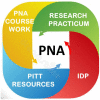A training program for researchers in population neuroimaging: Early experiences
- PMID: 37555144
- PMCID: PMC10406197
- DOI: 10.3389/fnimg.2022.896350
A training program for researchers in population neuroimaging: Early experiences
Abstract
Recent advances in neuroimaging create groundbreaking opportunities to better understand human neurological and psychiatric diseases, but also bring new challenges. With the advent of more and more sophisticated and efficient multimodal image processing software, we can now study much larger populations and integrate information from multiple modalities. In consequence, investigators that use neuroimaging techniques must also understand and apply principles of population sampling and contemporary data analytic techniques. The next generation of neuroimaging researchers must be skilled in numerous previously distinct disciplines and so a new integrated model of training is needed. This tutorial presents the rationale for such a new training model and presents the results from the first years of the training program focused on population neuroimaging of Alzheimer's Disease. This approach is applicable to other areas of population neuroimaging.
Keywords: Alzheimer's Disease; epidemiology; geroscience; neuroimaging; population neuroscience.
Copyright © 2022 Rosano.
Conflict of interest statement
The author declares that the research was conducted in the absence of any commercial or financial relationships that could be construed as a potential conflict of interest.
Figures


Similar articles
-
A Neuroimaging Web Services Interface as a Cyber Physical System for Medical Imaging and Data Management in Brain Research: Design Study.JMIR Med Inform. 2018 Apr 26;6(2):e26. doi: 10.2196/medinform.9063. JMIR Med Inform. 2018. PMID: 29699962 Free PMC article.
-
A guide for researchers seeking training in retrospective data harmonization for population neuroscience studies of Alzheimer's disease and related dementias.Front Neuroimaging. 2022;1:978350. doi: 10.3389/fnimg.2022.978350. Epub 2022 Sep 26. Front Neuroimaging. 2022. PMID: 37464990 Free PMC article.
-
PRATEEK: Integration of Multimodal Neuroimaging Data to Facilitate Advanced Brain Research.J Alzheimers Dis. 2021;83(1):305-317. doi: 10.3233/JAD-210440. J Alzheimers Dis. 2021. PMID: 34308905
-
Neuroimaging advances regarding subjective cognitive decline in preclinical Alzheimer's disease.Mol Neurodegener. 2020 Sep 22;15(1):55. doi: 10.1186/s13024-020-00395-3. Mol Neurodegener. 2020. PMID: 32962744 Free PMC article. Review.
-
Tau biomarkers in Alzheimer's disease: towards implementation in clinical practice and trials.Lancet Neurol. 2022 Aug;21(8):726-734. doi: 10.1016/S1474-4422(22)00168-5. Epub 2022 May 25. Lancet Neurol. 2022. PMID: 35643092 Review.
Cited by
-
Racial, Ethnic, and Geographic Diversity in Population Neuroscience.Curr Top Behav Neurosci. 2024;68:67-85. doi: 10.1007/7854_2024_475. Curr Top Behav Neurosci. 2024. PMID: 38844714 Free PMC article. Review.
References
-
- Alber J., Alladi S., Bae H. J., Barton D. A., Beckett L. A., Bell J. M., et al. . (2019). White matter hyperintensities in vascular contributions to cognitive impairment and dementia (VCID): knowledge gaps and opportunities. Alzheimers Dement. 5, 107–117. 10.1016/j.trci.2019.02.001 - DOI - PMC - PubMed
-
- Austad S. N. (2016). The geroscience hypothesis: is it possible to change the rate of aging? in Advances in Geroscience, eds Sierra F., Kohanski R. (Cham: Springer International Publishing; ), 1–36.
Publication types
LinkOut - more resources
Full Text Sources

